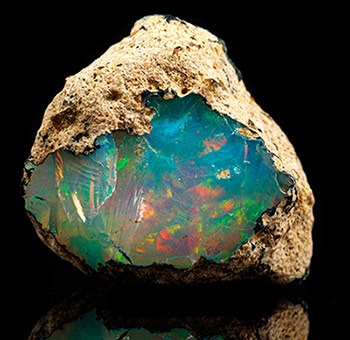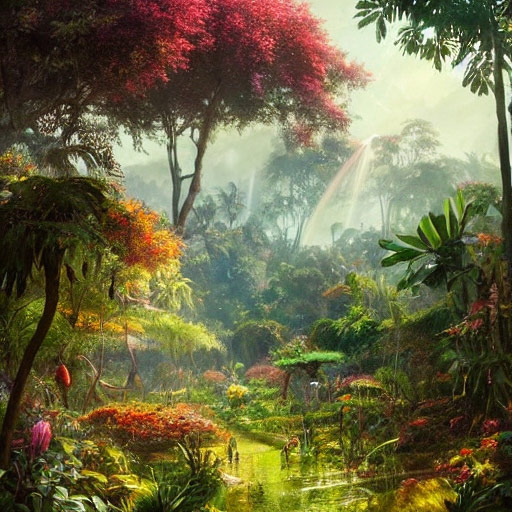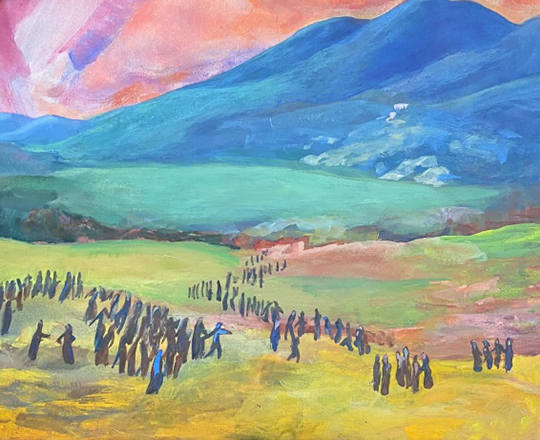
World’s Newest Gem Discovery
The world’s most important opal discovery occurred recently in East Africa on what might be the most inaccessible, unexpected place at the 400-foot level of a 1000-foot cliff. No one could have anticipated this awesome new gem find.

What is Garden of Eden Opal?
The Story and how it’s Rocking the Opal World
If the GIA (Gemological Institute of America) sends scientists, geologists, gem experts to the Garden of Eden in East Africa, the story they report is likely to hold most of the elements of what we are reporting. Our report is from people who have been there, gotten close, but no one I’ve talked to yet, has stood at the cliff face, stood at the entrance to the mine, looked in or carried a flashlight to the back wall where opal is being mined. So what we are reporting is from parties interested in opal who are circling this new gem location in concentric circles that are close or circles that radiate out from the center.
I know Maine gem miners. They keep tight circles around their mines. Few get in and when someone is allowed near, access is surprisingly limited and for good reason. The Garden of Eden opal location has every reason to be closed, tight, restricted and the government of this part of Africa has every right to be looking out for everyone’s best interest in this national treasure.
What we are reporting on this new opal find, is second-hand information. It’s interviewing seven blind men who have gone out, gotten close, but have not actually touched or seen the location, and they have returned and reported what they perceive to be true. We are reporting their observations as we understand them. This is the deeper story as we know it today. Inevitably more will come forth 10, 15 or 20 years from now, but by then it may be too late. Mines may be exhausted. Governments change, policies change, so much can change if we wait too long.
What we do know: A new find of an historic gem has been discovered. A new mine of solid, stable, unbelievably colored opal is now available. How long it will last – today, tomorrow, two years, 20 years, no one knows. What we do know is it is real. It is natural. It is available now and the color, the colors of this opal are setting new standards for opal in the world today. Even the language to describe these opals is changing. Some of the terms used by Australian opal experts no longer apply, a new language is emerging. As the story develops we will keep you updated.

The Cross NASA
Opal Challenge
Precious Gems Have Been Discovered on Mars
NASA has recently reported a major gem find on Mars. The Curiosity rover entered the Gale Crater and found seams of opal. We are challenging NASA to a quality competition. Their best opal from anywhere on Mars against any one of our Garden of Eden Opal from East Africa. The competition starts January 23, 2023, and extends for 10 years. NASA’s best versus any opal in our collection.

New wonders, new lands, new discoveries.
Space X and the Real Competition.
Here is what we believe, Musk’s mission to Mars through Space X is likely to put Space X in the lead position ahead of nation-states to actually occupy Mars. So, we are extending our opal quality competition to Musk and SpaceX or any other nation-state. Musk had set a date of 2029 for occupying Mars, which is just 6 years away, it fits nicely into our 10-year window. The competition is simple, it’s the best opal they can find anywhere on the planet Mars vs any of our Garden of Eden Opals.
NASA Can Choose the Judges.
The judges…can be their people. If they win, they get to keep our opal. If we win, we get to keep their gem. Our confidence in our challenge is the Garden of Eden Opal discovery represents the finest colored opal ever found on Planet Earth. Then again, we’re always searching for new best sources for gems. We would love to be the first to offer Martian opals. Seeking an awesome opal today? Check out our Garden of Eden Collection on our website.

Starship over Mars

We Know a Guy
Who Bought a Pickup Truck Load Of African Opal
from the Early East African Opal Find
I have an opal friend, who thirty years ago left college mid-term with his new bride and went to the south Pacific to start a South Sea pearl farm. Ended up in Australia, where he bought the equipment of a retiring opal miner and just started mining, cutting and selling opal and loving every minute of it; eventually buying three opal mines in Australia. He still owns one mine.
Over the years he became an accomplished opal cutter. Knew everything there was to know about Australian opal. At the 20 year mark he’d heard about a new discovery of opal in East Africa. Everyone was skeptical because of the stability of the opal that had been previously found in the region.
The Australian mining community was rife with rumors. Team Australia said no way, no how. Our American friend got hold of three of these new opal nodules and cut a collection of gems. He said for color he had never seen anything like it. It was Australia’s finest times 10. At giveaway prices he and the whole opal community had every right to be suspicious – awesome color with prices too good to be true.
He cut the gems and gave them the definitive opal strength and durability tests: tossed them into the freezer to super chill. Brought them out to intense heat then dopped them up with flaming hot wax, then plunged them into ice water. Kevin and Joann, his wife, were astonished. No Australian opal they had ever cut survived so much extreme testing.
 The new find was in 2008. In 2009 he made a decision, a commitment, and was in a position to make an historic acquisition. Not an ounce of gems, not a kilo or two, but an entire pickup truck of some of the most concentrated, fine, gemmy opal the world has ever seen.
The new find was in 2008. In 2009 he made a decision, a commitment, and was in a position to make an historic acquisition. Not an ounce of gems, not a kilo or two, but an entire pickup truck of some of the most concentrated, fine, gemmy opal the world has ever seen.
When I talk with him his eyes glitter. He’s got this smile, a knowing smile. It’s the look of a guy who is holding the billion dollar lottery ticket the next day after he’s visited the Lottery Commission. He has that look every time I see him.
Now we come to the really good part. By chance and serendipity, his wife has a degree in jewelry design, and not just a degree – she has an innate sense of awesome jewelry design. Simple, pure, 21st century Danish Modern-type design with just the slightest curve and frame to compliment and contrast in 22 Karat gold the awesome color performance of first cut early new gem opals. This is an historic collection.
We met Kevin in the desert. He had his entire collection of mounted opals. The quality of the gems before us was breathtaking. Colors and combinations of colors unlike anything we’d ever seen. Prices, like it was 40 years ago. If you are considering one of these new opals, don’t hesitate. Just be sure it’s one of the opals from this newest gem find that we call the Garden of Eden. With a Garden of Eden opal you possess all the colors of the earth in a stable, durable form.
How long will the find of Garden of Eden opal last? We hope forever, but alas all great gem discoveries are finite. For a while there are many, then suddenly it’s gone and everyone says I should have bought it back when. They are digging deeper into the cliff, tunneling, labor and extraction costs are rising. Two years, five years, ten years, how long will it last is one of the big unknowns.

“Why Now?” We Asked.
Gabriel Said, “By the Grace of God,
Our village really needed something like this.”
The tribe had lived for hundreds of years at the top of a thousand foot cliff, without ever realizing that at the 400-foot level the World’s greatest opal deposit laid within an 18-inch seam of rock.
Color so pure, so complex, so rich, and so wild it could have only been dreamed up by Mother Nature. This new find of opal in the Garden of Eden in East Africa will someday be regarded as one of the greatest gem finds of the 21st century. Jewelers everywhere are astounded. At Cross, we have a hard time believing that something so astonishingly beautiful could have been overlooked for so long.

New Opal Gem Find
World’s Most Important Opal Discovery in 100 Years
For 100 years Australia was the center of the opal universe. Colors and blends of colors unlike anything ever found anywhere on planet Earth. For years Japanese connoisseurs stood at the gates to Australian opal mines ready to buy the best and brightest gems. Prices reached astronomical heights. Then there was a discovery of opal by a shepherd boy in East Africa.
 Shown above, "Victoria Falls" a 37.86 carat East African Opal
from Cross’s private collection.
Shown above, "Victoria Falls" a 37.86 carat East African Opal
from Cross’s private collection.
Gemologists, gem collectors, jewelers took a deep breath. So awesome, so excellent is this find that we haven’t yet exhaled. This new East African opal discovery is a seam of opal 400 feet down on the face of a 1,000 foot cliff. They are mining this 14 inch seam of opal 10 feet, 20 feet, 30 feet deep into this cliff. One false step at the mine entrance and it’s 600 feet straight down to the valley below.
Opals are found on the cliffs in nodules the size of cherries, to the size of apples, filled with red, orange, yellow, green, blue, violet opal colors.

The Rains Returned
and the Land Became Lush and Green
Challenged by years of drought and famine. The world responded somewhat slowly. Logistics, gathering, and getting stuff there. No rain, no water, no crops, no food. In one season, in just a few months, all the food runs out. Hunger spreads rapidly.
It was tough for a while, really tough. Then the rains returned. Everything was lush and green again. Fruits and vegetables grew. Everyone was happy.
Then something else happened. A shepherd boy finds opal. It seems wild, beyond belief; people have lived in this area for
200,000 years so, “why now?” everyone asks. Gabriel, an African jeweler we met, said it well, “It  was God’s will.” The villagers at the top of the canyon, where just decades ago the world was sending food to feed the starving, the world was now coming to their village to secure a place at the auction to buy opal and not just any opal, some of the finest opal the world has ever seen. There is a parable here, a biblical story of sorts.
was God’s will.” The villagers at the top of the canyon, where just decades ago the world was sending food to feed the starving, the world was now coming to their village to secure a place at the auction to buy opal and not just any opal, some of the finest opal the world has ever seen. There is a parable here, a biblical story of sorts.
After the rains and after the harvest the men mine for opals in the dry time of year. It’s safer to mine after the rains stop. The miners are going deeper into the cliff. This cliff holds apples and pears of earth’s beauty. All the colors of life. The world now comes and sits at this villages doorstep, asking for the opportunity to be on the bidding schedule.
Spring Comes with Absolute Certainty
Gems Arrive and Disappear According to no set Schedule
A week early, a week late, but spring comes in many shades of green then in colors of flowers and later colors of fruits and vegetables. Spring comes with green grass, purple and white crocuses, and daffodils as yellow as the sun. Spring unfolds into summer and colors keep coming. The calendar can predict with near certainty when red roses bloom, when blueberries are ready for picking and the first orange pumpkins will appear.
Gems are rare. There is no season, no rhyme and little reason. They are exotic, precious and scarce. They are treasures waiting to be discovered. We mine tourmaline in Maine. We hunt for green, we hope for blue and maybe pink or watermelon too. Some summers are great, some summers little to nothing is found. Miners come back and mine for a year, or mine for ten years, until it is all gone. No one ever knows how long any gem mine will last.

Statement of Origin
All Garden of Eden Opal from Cross Jewelers comes with the above “Statement of Origin”; an important document for your records attesting to source and provenance of your new acquisition – from the early find in East Africa.
Celebration of Color
The following is an eclectic mix of thoughts and observations

Rainbows at the Gas Station
Gas slick at the gas station. Colors running across the cement surface. Entertaining myself taking pictures while the car fills with gas. One molecule thickness of gas separates purple from blue and blue from green and green from yellow. There is something so beautiful about how the physics of optics work. Every oil slick in the world follows the same rules. In a similar way, the colors in opal and their progression follow the same rules. Understanding this makes the study of opal so much more interesting.
When I was a kid, after a rainstorm, I remember we would go out looking for rainbows in puddles. Cars back in the fifties leaked oil and gas; it showed up in puddles. I haven’t seen a good rainbow gas slick in years until today while filling up. This is that slick. And no, I didn’t spill the gas.
We have introduced a new collection of African opals from East Africa. The optics and physics of the gas slick are substantially the same as the optics of an opal. Each color in a gas slick is a molecule thickness different than the next color. The same is true for opal.
As kids, we often got down on our stomachs beside the puddles after a rain to see if we could figure out what made the different colors. It was fifteen years later and a course in gemology on opals that revealed the secret of the physics of colors in both opals and gas slicks.

Even Trucks Have a Nice Day…
Are Pickup Trucks Driving Around
with Thousands Of Smiling Faces?
I could say this is a photograph of microscopic color molecules in opal all smiling with happy faces. It would not be true though. This is a close up of a black pickup truck in the grocery store parking lot. Photograph shows the sun on metallic paint. The camera was so close, the microscopic spicules of paint are enlarged and out of focus. I have no explanation for all the colored smiley faces.

Nancy’s Truck Full of Flowers
Last summer we restored an old flower garden – dug out the weeds then Nancy and I went flower shopping. This is the truckload of flowers we brought home, a dazzling array of color and diversity of delight. Nancy was thrilled with her new flowers even if they only lasted 6 weeks. We’re looking forward to this coming summer and an extended bloom season.
The Garden of Eden opals possess a wild array of natural color. Opals last longer than 6 or 12 weeks. They are millions of years old and with care will last your lifetime and your grandchildren’s lifetime.

Lawn Chair Colors at the Cellar Door Winery
We think in color. We celebrate in color. We imagine and design in color. There is a logic to color, a progression, and relationships. We honor color. Here are five Adirondack chairs at the Cellar Door Winery in Lincolnville, Maine, set on the hill overlooking the vineyard. Opals often possess the full dynamic range of colors.

Artist or God?
This is a photograph of a contemporary painting. Curves and swirls, red and blue and green and yellow. Who does wild color better, the artist with paintbrush in hand, or God in nature? God’s paintbrush is infinite. God always wins.

Opal Colors
Fruits and Vegetables
Fruits and vegetables are among nature’s best displays of brilliant primary colors. Red, orange, yellow, green are dreamy warm summer colors that play through the inner landscape of opal.

Garden of Eden Opal and the Four Second Vitamix
I keep a bowl of fruits on the kitchen counter for the wild colors and voluptuous shapes. Grapes, cherries, Valencia oranges, clementine’s, grapefruit, pears, bananas, Granny Smith apples, Macintosh apples, lemons, limes, tomatoes, avocado. Late afternoon 4 – 5 o’clock when the sun comes in the kitchen window the colors of my fruit bowl come alive. As ripening continues, the Vitamix is on the counter 2 feet away.
Curiously, depending on the mix, the blended fruits often come out a tan or taupe color. In traditional gems, ruby, emerald, sapphire, precious topaz, amethyst – the colors are bright, pure, true singular colors. In gem opal, a gem of joyful excess, colors are a four-second chop in a Vitamix mixer.
Opal colors are wild. They spin, shimmy, dip, swirl, scatter and shine. Little pieces of opal color confetti through each gem with colors all locked inside. Tilt the gem in the sunlight, colors play and echo inside. Colors dart, dash, appear and disappear then glint and gleam like ghosts. Opal, great opals, have whispers of color that never stop echoing through.

Opals After Sundown
Tuesday, February 20, 2018 5:21 PM. The sun has gone down. I’m sitting beneath the dining room light with three 45 watt high-intensity bulbs. I have made a random selection from our collection, a 4-carat pear shape opal. It looks like a dollop of Jello with a cascade of colors flowing through. It possesses all the colors of the rainbow, so much so that it looks like the best rainbow ever seen stuffed into a blender, poured out into a Jello mold, refrigerated for two hours, allowed to cool, solidify, cut and polished then set into 22K yellow gold.
Lying flat on my writing pad this opal is capturing, collecting light, then returning that light as a thousand points of color. Swooshes, swirls, flames of red licking the right and left sides, orange and yellow firing within, blues and greens and violets, cooling embers flickering from below.
Held vertically, all the colors shift and move. The opal becomes the flame above the candlewick. Colors sail through the interior.
Get close to the surface, inches away, tilt the opal slightly, red rolls across the surface, moves to a deeper red, then shifts orange, then shifts yellow. Green and yellow trade places, blue and purple slide into one another and out again. Colors morph and move according to rules of nature.

Pheasant Through Glass
12-15 years ago I was sitting at the breakfast table when there was a loud sound of breaking, then falling glass. I sat for a moment got up and went through the kitchen to the laundry room. I could see the large hole in the window then looked at the floor to see where the brick was. I couldn’t imagine anything else coming through the window. I looked toward my feet and saw something moving, gasping for air, wings in the last flutter. It was a big bird, a Pheasant. Catching last breaths, he died in moments.
I turned on the light and stood silently in awe at the brown, black, white and rust patterning, the order, symmetry of this bird of field and forest.
 When he stopped moving, I got down on my knees for a closer look. I’d never been this close to a bird that had just been alive. The feathers were so perfect. How the colors layered in, how they were grouped and layered, one color would stop and another begin. I studied my pheasant for a long time; the feathers coming up to the neck were brown with a clear white line, and then the most beautiful progression of green, blue, purple iridescent layered colors shimmering under the laundry room light. I was in awe of nature’s perfection.
When he stopped moving, I got down on my knees for a closer look. I’d never been this close to a bird that had just been alive. The feathers were so perfect. How the colors layered in, how they were grouped and layered, one color would stop and another begin. I studied my pheasant for a long time; the feathers coming up to the neck were brown with a clear white line, and then the most beautiful progression of green, blue, purple iridescent layered colors shimmering under the laundry room light. I was in awe of nature’s perfection.
I felt for this bird and whatever he was suddenly escaping that sent him through my window. I left him there, closed the door with the intention of settling things in the evening when I returned from work.
That evening I took the pheasant down to the lower yard and laid him on a large granite boulder by the stream and again spent time studying feathers, patterns, colors, color shifts and the iridescent green, blue purple around his neck, natural living colors I’d never seen so close before. That nature can create color in a living creature and also in an opal gemstone seems amazing.

Opal Dart Toss
Choosing from a line-up of any dozen Garden of Eden opals. Toss a dart, whichever one it lands near is the best.

Galway Disco
A long time ago I went on a group trip with the Institute for Noetic Sciences to Ireland. The poet John O’Donahue hosted our Anam Cara jaunt. We toured for a week along the west coast of Ireland north of Galway.
One night a group of us decided to go dancing. I was in my 40s. I agreed and went along. The music was loud. We went to a club. It was shoulder to shoulder, colored light pinpoint glitter rainbows, shooting everywhere. We stayed until the other 40-somethings decided we were having more fun than anyone over 25 deserves. My take away 20 years later is that the colors of a spinning disco ball are like stepping inside of a living breathing music filled opal.

Ghost Rainbow
Sunrise. Sun on the edge of the horizon, coming through a high window into the still dark room. Pure red, orange, yellow, then a big stretch of green, then on to blue and purple. Catch a glance in the morning light, blink, and then it’s gone. Opal, millions of years old, capturing all the colors of the earth. Solid, tactile, real. Take one home.

Butterflies Like Opals
I grew up on a farm in the 1950s, 20 miles outside of the city of Portland. We had 40 acres of hayfield and thousands of butterflies in July and August. Viceroy, Monarch, and yellow and black Swallowtail. The yellow and black Swallowtail had blue and red iridescent dots that glowed like opals.
Spring Rains
I’m not sure where the sun rises over the opal mines. I imagine the mine on the cliff on the western side of the river valley and that when the sun rises, its first rays of dawn bounce off the cliffs. The first rays of a new day go right into the tunnels and fire up the opal.

Pure White is All Color
Or All Colors Divided and Thoroughly Stirred
Snow. The fury of the gale. Wind pounding the side of the house. The light at the porch corner catching the snow whipping by. All earth pure black and pure white, no color outside. While inside I sort opals.
 I am sitting this evening in the midst of another late spring snow storm. The world is devoid of color. Just white and shades of gray. All the detail and precision of light, lost just a few feet away from the house in a haze and flurry of snowflakes racing in the wind from north to south. Later this evening I will sit with a riot of color. Opal discovered 10 years ago, opal mined in the cliffs beneath a remote village in East Africa.
I am sitting this evening in the midst of another late spring snow storm. The world is devoid of color. Just white and shades of gray. All the detail and precision of light, lost just a few feet away from the house in a haze and flurry of snowflakes racing in the wind from north to south. Later this evening I will sit with a riot of color. Opal discovered 10 years ago, opal mined in the cliffs beneath a remote village in East Africa.
The villagers go to the cliffs to mine opal. The cliff drops a thousand feet down to the river. Four hundred feet down from the plateau and town, there is a seam of rock in the cliff that contains the most beautiful opal in the world.
They mine chunks of opal the size of cherries to the size of oranges. Inside each of the opal chunks are all the colors of the world, opal with intensity and patterns of color no one has ever seen before. Someone said, “it’s as though you took all the rainbows ever seen on planet earth, all the colors of sunrises and sunsets, took all the tropical fish, birds, flowers, it’s as though you gathered all the colors of summer, all the colors of fruits and vegetables, butterflies and flowers and shrunk them down, put them in these spheres and then planted them beneath this tiny village in East Africa.”

There Was an Apple
In the Garden of Eden
Some might say it was the beginning of all the trouble. Others might say, because it came from the Tree of Knowledge we were able to see with color and clarity for the first time. There has been a discovery in East Africa’s Garden of Eden. Opal the size of cherries, the size of apples in colors, unlike anything the world has ever seen before.
We met an early investor, an opal cutter and his wife, a jewelry designer. We’ve never seen anything so beautiful, so exquisite, so preciously dappled with racing colors as these gems that make up our Garden of Eden Opal Collection. Our collection is 22K gold in the opal surround, attached findings are 14K yellow gold.
How to Acquire One of These New African Opals
- You can click and buy on our website.
- You can click and call Mon – Fri 9:30am to 5pm Eastern Standard Time.
Shipping is Free Anywhere USA
Guarantee: Your complete and total satisfaction is 100% guaranteed. You may return it for ANY reason. Simply return for a full original price to your credit card, no questions asked. We want you to be totally satisfied. Full 30 day return privileges on any piece of Garden of Eden opal jewelry.










 The new find was in 2008. In 2009 he made a decision, a commitment, and was in a position to make an historic acquisition. Not an ounce of gems, not a kilo or two, but an entire pickup truck of some of the most concentrated, fine, gemmy opal the world has ever seen.
The new find was in 2008. In 2009 he made a decision, a commitment, and was in a position to make an historic acquisition. Not an ounce of gems, not a kilo or two, but an entire pickup truck of some of the most concentrated, fine, gemmy opal the world has ever seen.

 Shown above, "Victoria Falls" a 37.86 carat East African Opal
from Cross’s private collection.
Shown above, "Victoria Falls" a 37.86 carat East African Opal
from Cross’s private collection.
 was God’s will.” The villagers at the top of the canyon, where just decades ago the world was sending food to feed the starving, the world was now coming to their village to secure a place at the auction to buy opal and not just any opal, some of the finest opal the world has ever seen. There is a parable here, a biblical story of sorts.
was God’s will.” The villagers at the top of the canyon, where just decades ago the world was sending food to feed the starving, the world was now coming to their village to secure a place at the auction to buy opal and not just any opal, some of the finest opal the world has ever seen. There is a parable here, a biblical story of sorts.









 When he stopped moving, I got down on my knees for a closer look. I’d never been this close to a bird that had just been alive. The feathers were so perfect. How the colors layered in, how they were grouped and layered, one color would stop and another begin. I studied my pheasant for a long time; the feathers coming up to the neck were brown with a clear white line, and then the most beautiful progression of green, blue, purple iridescent layered colors shimmering under the laundry room light. I was in awe of nature’s perfection.
When he stopped moving, I got down on my knees for a closer look. I’d never been this close to a bird that had just been alive. The feathers were so perfect. How the colors layered in, how they were grouped and layered, one color would stop and another begin. I studied my pheasant for a long time; the feathers coming up to the neck were brown with a clear white line, and then the most beautiful progression of green, blue, purple iridescent layered colors shimmering under the laundry room light. I was in awe of nature’s perfection.




 I am sitting this evening in the midst of another late spring snow storm. The world is devoid of color. Just white and shades of gray. All the detail and precision of light, lost just a few feet away from the house in a haze and flurry of snowflakes racing in the wind from north to south. Later this evening I will sit with a riot of color. Opal discovered 10 years ago, opal mined in the cliffs beneath a remote village in East Africa.
I am sitting this evening in the midst of another late spring snow storm. The world is devoid of color. Just white and shades of gray. All the detail and precision of light, lost just a few feet away from the house in a haze and flurry of snowflakes racing in the wind from north to south. Later this evening I will sit with a riot of color. Opal discovered 10 years ago, opal mined in the cliffs beneath a remote village in East Africa.
